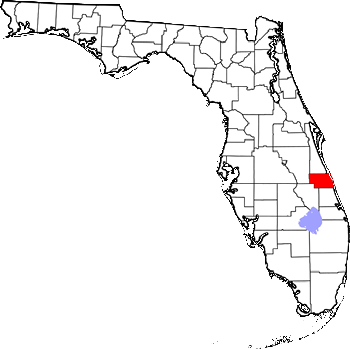The changes in Florida county borders
“Beginning at the northwest corner of township thirty-one south, of range thirty-five east.”
That’s the way the law begins.
… thence east on the line dividing the townships thirty and thirty-one south, to the point where said line intersects the thread of the south fork of the St. Sebastian River; thence northerly down the thread of said stream to the main stream of the St. Sebastian River; thence down the thread of the St. Sebastian River to its confluence with the Indian River; thence east to the intersection with the southwesterly extension of the centerline of the approach channel to the Sebastian Inlet from the Indian River; thence northeasterly along said centerline and continue northeasterly and easterly along the centerline of the Sebastian Inlet to the Atlantic Ocean; thence southward along the Atlantic coast, including the waters of the Atlantic Ocean within the jurisdiction of the State of Florida to the township line between townships thirty-three and thirty-four south; thence west on said township line to range line dividing ranges thirty-five and thirty-six east; thence north between ranges thirty-five and thirty-six east to the northeast corner of section one, township thirty-three south, range thirty-five east; thence west on township line dividing townships thirty-two and thirty-three south, range thirty-five east to the range line dividing ranges thirty-four and thirty-five east; thence north on said range line to the northwest corner of township thirty-one south, range thirty-five east, being the place of beginning.1
The law? Creating a new county in the State of Florida, one of the last four ever created in the Sunshine State. Indian River County was created in 1925 along with Gilchrist,2 Gulf3 and Martin Counties.4
 And, yeah, no surprise, The Legal Genealogist did come across this statute while poking around Florida laws in preparation for this weekend’s 2017 Valentine Genealogy Seminar of the Indian River Genealogical Society, at McAfee Hall, First Presbyterian Church, Vero Beach, Florida.
And, yeah, no surprise, The Legal Genealogist did come across this statute while poking around Florida laws in preparation for this weekend’s 2017 Valentine Genealogy Seminar of the Indian River Genealogical Society, at McAfee Hall, First Presbyterian Church, Vero Beach, Florida.
It’s the statutes that we’ll be talking about much of the time on Saturday there in Vero Beach: what they are, where to find them, and what they tell us.
And figuring out those county lines is a key part of what the laws have to tell us.
If you wanted to find an ancestor who lived in Vero Beach, for example, where would you look for his or her family in the 1920 census?
It wouldn’t be in Indian River County, now, would it? Because that county didn’t exist until 1925.
No, in 1920, you’d be looking in St. Lucie County. created in 1905.5
But what if you were looking for that same family in 1900?
Even if that family never moved, you’d be looking at yet another county: the area that became St. Lucie and later Indian River was in Brevard County in 1900.6
And Brevard County before 1855? It was called St. Lucia.7
And before 1844, when St. Lucia County was created, it was in Mosquito County.8
All of those changes are set out in Florida’s laws.
And that’s just one of the things the laws tell genealogists.
Just one of the reasons why, to understand the records, we have to understand the laws of the time and the place.
SOURCES
- §1, Florida Laws of 1925, chapter 10148, set out in 2016 Florida Statutes, Title II, Chapter 7, §7.31, Online Sunshine (http://www.leg.state.fl.us/Statutes/ : accessed 22 Feb 2017). ↩
- Ibid., §1, Florida Laws of 1925, chapter 11371, set out in 2016 Florida Statutes, §7.21. ↩
- Ibid., §1, Florida Laws of 1925, chapter 10132, set out in 2016 Florida Statutes, §7.23. ↩
- Ibid., §1, Florida Laws of 1925, chapter 10180, set out in 2016 Florida Statutes, §7.43. ↩
- Ibid., §§1, 19, Florida Laws of 1905, chapter 5567, set out in 2016 Florida Statutes, §7.59. ↩
- See Wikipedia (http://www.wikipedia.com), “Indian River County, Florida,” rev. 13 Feb 2017. ↩
- Ibid. ↩
- Ibid. ↩



I will be driving from Brevard County to Vero Beach to hear you speak. I love reading your blog especially about your Parker County Texas ancestors as I have ancestors from there and Tarrant and Wise County too. I have wondered if they knew each other.
We’ll have to compare notes!!